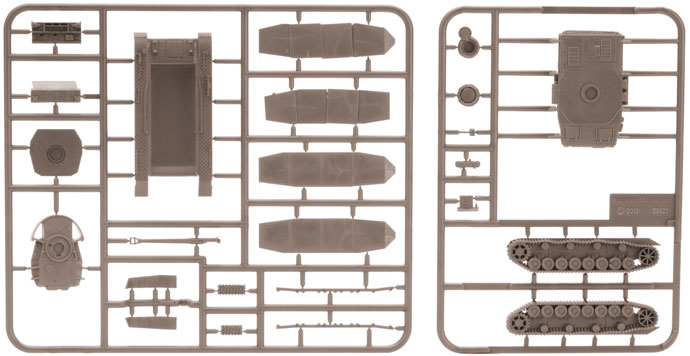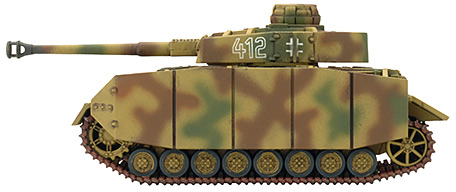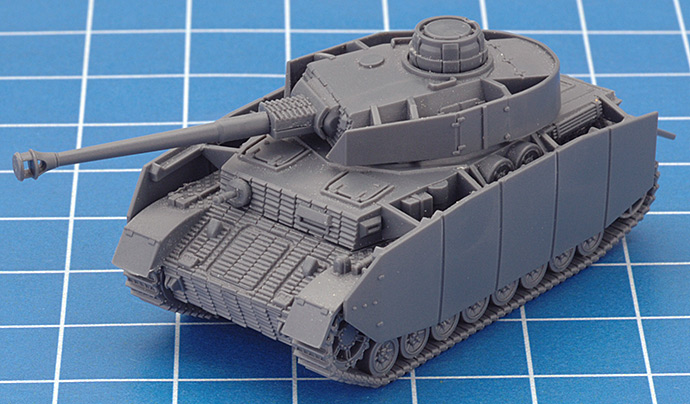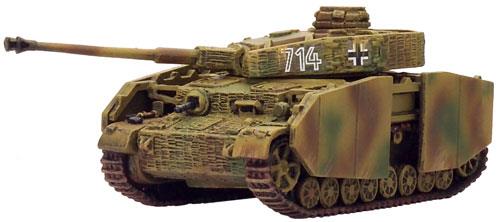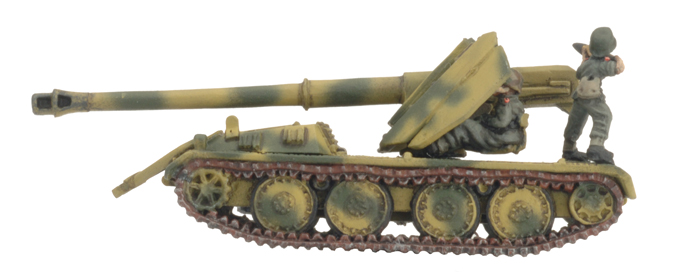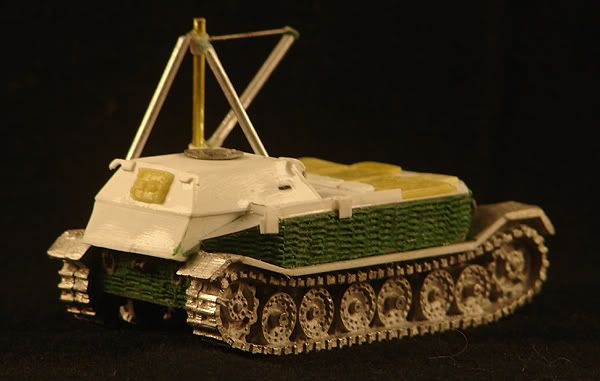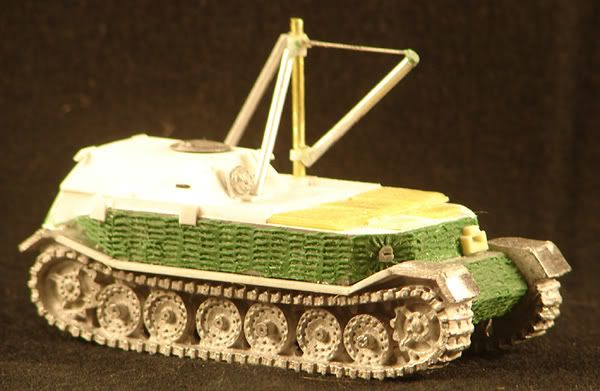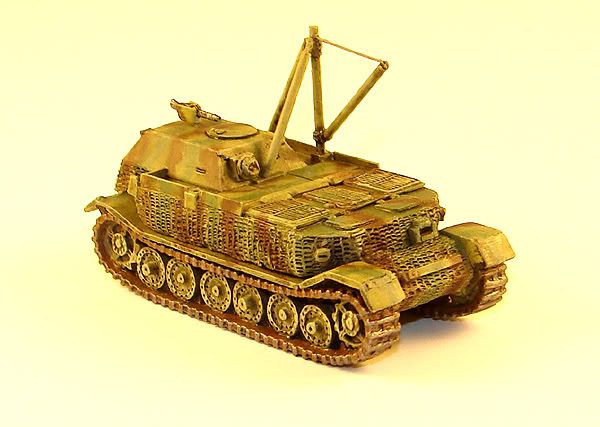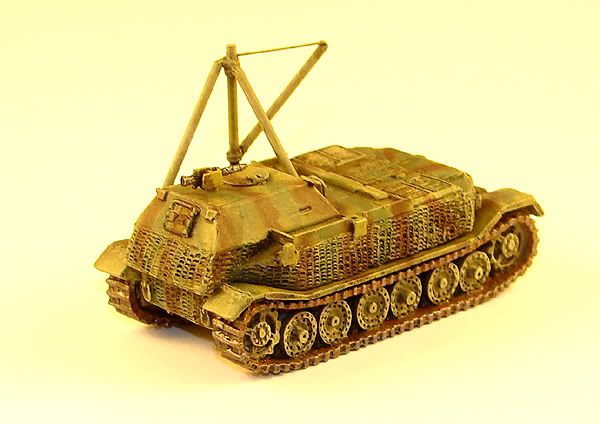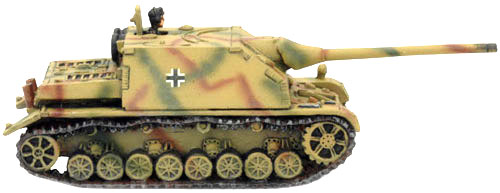The M4A2 was the most common diesel-powered version of the ubiquitous Sherman tank. Powered by the GM 6046 engine, it gave the M4A2 a very strong power to weight ratio, though the engine experienced some initial reliability issues. Over the course of the war, nearly 11,000 M4A2 variants were produced with roughly 8000 of those being armed with the 75mm gun (April 1942 to May 1944 production), and the remaining 3000 armed with the 76mm gun (May 1944 through May 1945 production).
While the U.S. Army decided to limit overseas deployment to gasoline powered models of the Sherman, the diesel M4A2 was still utilized in large numbers by other operators. The U.S. Marine Corps used the M4A2 during the Pacific campaign, but eventually began to transition to the M4A3 variants. The Soviet Union was ultimately largest combat user of the M4A2. During the course of the war the Soviets received roughly 4100 vehicles (50% 75mm / 50% 76mm) through Lend Lease.
As with the other Sherman models, the M4A2 underwent a variety of changes during its production run. At this point Battlefront only makes two M4A2 variants which don't fully represent the variety fielded by the Soviets during World War II. However, with a little work you can get every variant used in the European war using the two M4A2 miniatures and the new plastic M4A3 (UBX44) box. There were HVSS versions of the M4A2 provided to the Soviet Union, but these were only used in the Manchurian campaign.
The basic M4A2 Sherman (SU071) provided by Battlefront is one of the earlier small hatch variants. Production of this version began in roughly April 1943 when the direct vision slits were eliminated and replaced with periscopes. Ammunition stowage was still dry. The 75mm turret is also one of the earlier types with a pistol port, but no loader's hatch (D50878). While most of these vehicles were produced in early to mid 1943, there is at least one picture of such a vehicle in 1945 in Vienna, Austria. The drive sprocket is the earlier "open" style and comes from the original plastic Sherman track set.
The 76mm M4A2 Sherman (SU073) miniature combines the M4A2 large hatch hull with wet ammunition stowage (i.e. "protected ammo"). The turrent is an "oval hatch" variant of the 76mm Sherman turret, which appears to have been common to most of the M4A2 provided to the USSR. Versions both with and without a muzzle brake were provided to the Soviet Union, but the miniature only provides the sans muzzle brake variant. By 1945 there seemed to have been a large number fielded with the muzzle brake, especially for the final push into Germany itself. I've therefore updated the original Battlefront miniature with the M4A3 plastic gun with muzzle brake. I've also added the plastic tracks as they have a good steel track pattern on them and the "economy" drive sprocket. These vehicles were all produced in 1944 and deliveries to the Soviets began in the fourth quarter of that year.
There is, however, a large production gap between the early style miniature (SU071) and the 76mm version (SU073). During that time the M4A2 transitioned to a large hatch variant with the 75mm gun. As at least one army I'd like to field some day uses that variant, I had to create it myself. The large hatch M4A2 was first introduced with dry ammunition stowage. To protect the vulnerable stowage bins, applique armor was applied in three locations to the outside of the tank (it's debatable as to whether or not this would count as "protected ammo"). To produce this version, I took one of the 76mm hulls, added the additional armor plates, and began casting copies of it.
I borrowed the 75mm turrets from the M4A3 plastic box as they have the right combination of commander's hatch and loader's hatch to represent this variant of the M4A2. The tracks include the correct "economy" drive sprocket and are available through Battlefront special order as USO183. As the texture of the plastic is very smooth, I used some plastic cement and a stipple brush to provide some cast texture to the sides of the turret.
While I can quibble with some of the details of the plastic M4A3 boxed set - overall I must say that Battlefront has engineered a solid and easy to construct miniature. Another plus is the pieces are generally compatible with the existing inventory of resin and metal miniatures making it easy to swap parts between the two. By way of comparison I've recently picked up a Zvezda 1/100th M4A2 late (with muzzle brake). Zvezda's kit is cheaper per vehicle, and in many ways it is more accurately detailed. However, the construction of the Zvezda kit is much more reminiscent of a larger scale model kit than a miniature with fine details that only experienced modelers will be able to take advantage of in 15mm scale. The way the pieces are broken up will also result in some very odd gaps or seams in the final figure.
In game terms, the large hatch 75mm M4A2 should probably have the Front Armor 7 of the later 76mm version, though with the applique armor, I doubt it would count as "protected ammo" in game terms - that distinction seems to come with the "wet" ammunition stowage which was introduced later. I'm simply going to run them as standard 75mm M4A2 tanks. Personally I'd like to see the option at some point for the Soviet Sherman lists, but that would require a lot more granularity than we've gotten at this point for the Inomarochnikiy Tankovy Batalon (Lend-Lease Tank Battalion).
Overall I'm happy with how I was able to take the existing Battlefront parts and generate any version of the M4A2 I needed with very little casting required. Now I have to decide whether I'm going with an army like this for an upcoming tournament or something that has fewer moving parts.
Miniature Ordnance Review looks at the world of historical and fantasy miniatures wargaming and model building. From 15mm Flames of War, to Warhammer 40K, to 1/35th scale tanks, with some potential surprises on the horizon - you'll find them here!
Sunday, October 18, 2015
Thursday, October 1, 2015
Upcoming "1945" Tournament!
In honor of Battlefront releasing "Berlin" - which at least chronologically wraps up the war in Europe, there will be a "1945" tournament at Guardian Games on November 14, 2015. Lists must come from a handbook or online / digital list that includes the year 1945 - so there won't be any Normandy or Market Garden lists included in this particular tournament. The point value is also higher than I've generally done - 1945 points in honor of the year.
The thing is, I'm in a quandary about what to bring for this particular tournament. To be completely honest, I've been extremely busy with writing this summer - along with other non-Flames of War hobbies and responsibilities (yes - I do have some!), and my Polish Black Brigade is still begging to be finished up (it's getting there, but not THERE yet dang it). That means space and time have been at a premium, but I've had a few projects on the back burner that I've slowly been working through.
By and large I've been an Axis player - the more unusual the army the better. One of the forces I've been looking at is 26. Panzerdivision from Fortress Italy. I have some good research data on the unit including some wonderful markings for the unit's Panthers, Panzer IV's, and Stug IV's (yes - IV!) from the Firefly collection book, To the Last Bullet: Germany's War on Three Fronts, Part 2: Italy. The unit has some nice modified Panthers, but for its capability, the Panther is very expensive and fragile in very "Late War" games. Even with a lot of Panzer IV/Stug IV support, it is going to be a tough army to attack with successfully - especially at high point values. Generally at high point values the Reluctant Trained Panthers seem to do better on sheer volume, though you'll not likely get a lot of 6-1's.
Given I wrote the German section of the Bridge at Remagen book, there are still several armies in that work I'd like to field. The Jagdtigers of 512. Schwere Panzerjäger Abteilung have always been a favorite of mine, and at 1945 points, I think both the CV and RT versions would both be viable, though the RT would I think work a little bit better because you'd have more big guns and the option of Carius. 654. Schwere Panzerjäger Abteilung would also be interesting, and I've already started working up some of their Jagdpanthers, but unfortunately they have the same issue Panthers have - they're fairly fragile for the points cost. SS-Panzer Brigade ‘Westfalen’ would also be interesting, and is a really decent defensive army with some strong armored support, but I'd have to paint up a bunch of SS figures (and the LW Battlefront minis often have issues) - and just about anything out of Remagen is going to need Volkssturm support - which is a large time sink for figure painting.
Given the large point-value of the games, I've also considered a couple of the Berlin lists (again, as I did a fair bit of research and writing for that book as well). The Berlin Kampfgruppe gives you so many options, you can tailor build a force to your liking. I was thinking of running a fortified company with a mix of Heer, Volkssturm, and Hitlerjugend with Panther Turret bunkers. I've even considered throwing in either Elefants from 614. Schwere Panzerjägerkompanie or the Krupp-Steyr Waffenträger as well. Depending on the mix of missions, fortified companies can do well, or fail miserably at a tournament like this - especially at these point values. However, while I really want to do this army some day for purely historical reasons, it would involve a lot of infantry painting as opposed to vehicle painting, and I'm a much more efficient (and better) vehicle painter than infantry / gun crew painter. I'm looking at least a couple of Volkssturm units, Hiterjugend, at least a platoon or two of Heer, machine guns, anti-aircraft guns (those 3.7cm Flakzwilling are too good to pass up) - and I just don't think I have the time to do the force justice.
Another list I've considered is the Panzerdivision Müncheberg list on Flames of War digital. I helped sort out the force organization for this one, but as with the 26. Panzerdivision list above, the core of the unit is fairly expensive - Panthers and Tigers - and given the proliferation of high AT Allied weapons, they're now fairly fragile. I know I could work up a very historical force, but I think the core of it (4 Panthers and 3 Tigers) could easily be wiped out in a turn facing something like British Comets.
Then there's Allied forces. I've always wanted to do a force representing the all African-American 761st Tank Battalion, but the current lists always seem to fall a little short of representing the unique character of this unit. One of the 1945 confident veteran or confident trained lists would likely work okay, but going trained would lend itself to putting together an "Arty Party" which is unbalanced. It would run well in the tournament, but would lack the feel of the unit in my view.
There's another good Firefly Collection book, Comrade Emcha: Red Army Shermans of WW2, that has a lot of great photographs and color plates, including some good force organizations to build a great Berlin Soviet lend-lease tank unit from Red Bear. I've also recently picked up Dmitriy Loza's autobiography, which is another great source of inspiration for this army. I could theoretically run a mixture of 76mm and 75mm M4A2 Shermans in this list - though I'd need to update a lot of the 75mm M4A2's to the "large hatch" versions as most of the "small hatch" versions had been destroyed at this point (though there is photographic evidence of a few surviving). I know Valentines were being used during the assault on Küstrin, so I could throw them in as well. Throw in Loza and Nevsky and you've got a force with a lot of alpha punch... but on the downside it is a lot of painting to punch it out to 1945 points.
So as I said... I'm in a quandary. There's reasons for and against running each list. Historically they all have something very solid to offer. Each unit tells its own important story about the state of the war and that particular group's role in it. In terms of game mechanics, I think any list where the German tanks remain fairly safe from the front when faced with Allied AT assets is going to have an advantage over those that don't - but my RT King Tiger list from last year was still delicate to play. I think I'm more likely to win games with the Allied lists at this point, but my primary goal has never been to max/min the heck out of a list for a Flames of War tournament.
If you have any thoughts or suggestions, feel free to put them in the comments below!
If you have any thoughts or suggestions, feel free to put them in the comments below!
Monday, August 31, 2015
Battlefront's Panzerkampfwagen IV Ausf H - and a New Army
I've got a late-war tournament coming up in roughly November, and the theme is "1945" - and the tournament will be 1945 points. I avoided the temptation of going with a fortified list from Berlin, because I thought it would be a bit beardy, so after wracking my brain for a list I wanted to do (which sadly doesn't include the lovely Panzer IV/70 (A) unit I've been working on in the background - as they're Autumn 1944... sort of the whole theme of that one...) I finally settled on something. More on that later, but the new list does give me a chance to use several Panzerkampfwagen IV Ausf H, alongside a few Panthers, and even some Stug IV's - yes, you read that right IV - not your garden variety III - in a tank list. Once again I'll likely die horribly, but will hopefully look good while doing it.
With a mini-host of Panzer IV Ausf H needed for the new army, and given the fact that I had a spare lying around from my aforementioned Panzer IV/70 (A) project, I decided to go ahead and build up one of the all plastic tanks from the Panzer IV H Platoon (GBX79). The original release of this miniature was a bit of a fiasco. Not only did it retain the mistake on the idler from the Ausf J plastic parts sprue, detailed in my earlier blog, but it had the wrong number of Schürtzen plates as well. As an interim measure Battlefront provided free copies of the old Panzer IV H Schürtzen (GSO186), but they ultimately had to go back and rework the tooling for this one as the errors were so bad. Fortunately they also cleaned up the idler in the process (now if they’d just go back and fix the Ausf J as well).
Above is a sprue from the original run - you can see the issues with the Schürtzen and idler. A painted copy is below, which shows how far the error went before it was caught when it was released into the wild.
Fortunately Battlefront improved the kit... drastically. It now has the correct number of Schürtzen and the idler is correct as well. The only nit I can pick with the suspension is that all of the wheels are oriented the same way, not as big on the Panzer IV, but they do the same thing on the Stug III, and it looks a bit odd as you never see a real vehicle with it's wheels lined up perfectly.
As pretty much every Panzer IV Ausf H had zimmerit, the plastic version has it molded in. The only drawback here is that the zimmerit looks a bit heavy and blocky to my taste. Compare the plastic version:
To the earlier resin version (GE046):
The zimmerit is much finer on the resin version. That being said, there are a lot of drawbacks to the old resin version. Installing the Schürtzen was always a royal pain in the butt. The turret Schürtzen were molded to the turret, generally with very thick hunks of resin along the bottom of the turret (I generally drilled mine out - which was also a pain in the butt). The tracks aren't nearly as nice either, though the road-wheels are molded as single cylinders rather than two wheels in parallel (if you put the Schürtzen on, you'll never see that part, though). The hull machine gun is a bit better on the old resin version, but the new one isn't bad.
All that being said, the new kit has two big advantages: 1) it's plastic and 2) the FIT. I'll start with the second one first. I continue to be impressed with the fit of the new Battlefront plastics. The Panzer IV breaks down logically into sub-assemblies, and the fit is outstanding across the board. Very little filling and puttying is needed (and that's only if you suffer from AMS - Advanced Modeler's Syndrome). The turret bottom plate can use some putty up front, and the two halves of the gun recuperator have a bit of a seam. Rare earth magnets fit easily in the top hull and the turret bottom to create a very good join between the two.
The second advantage is it is plastic. Conversions and modifications that are extremely challenging in resin and white metal see their degree of difficulty drop considerably in plastic. I'm honestly not making major changes to my Panzer IV's (other than adding some stowage and what not). The only thing I'm doing is toning down the zimmerit a bit - which is child's play - because it's PLASTIC. All it takes is a liberal dousing in liquid plastic cement (as it is a solvent - not a "glue") and it will soften those hard edges quickly.
Looking at the miniature in the previews and on the web, I was far less impressed with it than I have been in person. Softening the rough edges of the zimmerit was exceptionally easy, and the whole thing went together very quickly. Having just built up several StuG IV miniatures, I can also say I appreciated the fact that the barrel was molded with an open muzzle brake, so I don't have to drill that out myself. I'm honestly looking forward to getting more of them to finish the set, though I'm having to be careful to make sure I get the right ones - the pre-fix copies are less than useless to me.
Sunday, August 16, 2015
Krupp-Steyr Waffenträger from Heer 46
With the release of the Berlin supplement for Flames of War, there are a few of the more
unusual self-propelled anti-tank vehicles available to take in your Berlin Kampfgruppe. Battlefront
included the 8.8cm PaK43 auf Waffenträger
as an option in the Tank-hunter Platoon on page 25. However, the Germans ended
up producing several different Waffenträger
on the venerable Panzer 38(t) chassis, and at this point Battlefront only produces one variant. Their version appears to be
the Ardelt prototype, and is available in a full unit of three as the Waffenträger
Tank-hunter Platoon (GBX88). These are neat vehicles, but I’ve always liked the
look of the Krupp-Steyr version a bit better, known as the leichte Einheitswaffenträger fur 8.8cm PaK 43/3.
The Ardelt prototype simply mounted the PaK43 in a pretty
much unaltered form on the back of the vehicle (shown below). This effectively created a fully mobile PaK 43 anti-tank gun, though aiming the gun through a
larger arc could be problematic as the vehicle itself was somewhat narrow. This
results in the vehicle having the “Awkward layout” special rule in the
game.
The Krupp version looks a bit more elegant with the large PaK 34 being housed in a small turret on the rear of the vehicle. The vehicle itself is a bit lower to the ground, and the turret in the rear is very tiny, so in game terms it would retain the "Awkward layout" rule.
While Battlefront doesn't make a miniature of this version of the Waffenträger, Heer 46 does, though he tends to sell out of his more popular miniatures frequently - it may take several visits or an email to get one in stock. Heer 46 specializes in hypothetical and prototype armor from late World War II with a focus on German subjects. Many of his products begin with 3D-printed masters, which on many subjects leads to a certain level of simplification. However, the detailing on the Krupp Waffenträger is quite good overall. It helps that the vehicle itself is slab sided with only a few details.
Overall the casting on the hull is quite good, especially for a cottage industry product, but it isn't without its problems. The mounting hole for the turret is too shallow and had to be drilled out. With the weight of the white metal main armament added, a rare earth magnet is NOT optional, and since the size of the hole is smaller than the standard Battlefront version, I'm going to need to pick up some smaller magnets.
The only glaring problem with the miniature is in the deck and rear hull casting. It is clear that the sprue attaches through the back hull, and the clean-up job (remember - likely done by hand!) isn't perfect. The deck itself has shrunk away from the mold creating a concave rather than flat profile for the upper hull. Given the rest of the detailing is so good, I'm not going to bother with correcting it. There are also some resin bubbles typically found around the rear axle, but an engraving tool makes short work of those.
The kit includes canvas covers for the turret, but I'm going to model all three of mine with the turret open. The turret sides are thick molded (the sides drop vertically from the top rather than following the angle of the plate), but throw in a couple of crewmen and you'll never notice!
What really sold me on this model was the running gear, which is absolutely beautiful! The front fenders are VERY thin and the detail on the roadwheels and sprockets is amazing for this scale. They'll paint up very nicely.
The gun is white metal, and two out of the three I received were nearly flawless. The third had only a bit of mold slippage. Bear in mind you may have to do a fair amount of straightening as Heer 46 uses minimal packaging and mine took a little bit of a beating coming over from Europe! I'm going to add a couple of figures from the Vehicle Artillery Crew (GSO114) and a few left over from other vehicles as the miniatures themselves came with no crew. Given the stats should be exactly the same, I plan on using these little beasts as the Waffenträger in one of my Flames of War armies using the Berlin book or the digital lists.
If you're ambitious, there are several more variants of the Waffenträger out there. In an earlier blog, I mentioned the Ammo of Mig 1945 weathering magazine covering "1945." The issue also includes an exceptionally well executed Waffenträger by Sergiucz Pęczek that is based on what appears to be fairly standard Panzer 38(t) running gear. His version is a Rheinmetall/Ardelt prototype combination which was produced in April, 1944.
Friday, August 14, 2015
Building the Bergetiger (P)
First I want to apologize again for the lack of posts,
I've been continuing to work on my Black Brigade - they're now in the basing
stage. I've also been writing for a project that will be released later in the
year - I can't go into details yet, but watch this space for more information
in a few months. So without further ado - on to the post!
The Elefants and funnies of 653 Schwere Panzerjäger
Abteilung remain a popular (and fun to model) army for Flames of War. Building
some of the vehicles may seem daunting at first, but with a bit of patience
most modelers can successfully perform the conversions.
The key to any good conversion is starting with a good
set of plans. Plans for the Bergetiger (P) are available in several reference
books and online. The next step is to use imaging software to scale the drawings
to match the miniature. In this case you’ll want to use the Tiger (P) (GE076) miniature.
I typically use a set of digital or analog calipers to measure the key
dimensions on the drawing which will give me a scaling factor in the imaging
software. It is always best to use a longer measurement (like length) because
the impact of measurement error will be minimized. When scaling, it is also
best to scale all of the plans as one set of drawings rather than trying to
scale them as individual drawings.
With your scaled plans in hand, you can now begin to
actually convert the miniature. The Battlefront Tiger (P) miniature has the
very early fenders which don’t extend beyond the vehicle sides for most of the length
of the vehicle. To fix this, simply add some plastic card and sand it down to
create an even fender profile along the whole length of the miniature.
Unless you want to scratch-build a lot of the details on
the miniature, you’ll need to either borrow bits from other flames of war
miniatures or cast portions of other miniatures to use as templates. For the
Bergetiger (P) you’ll need the following details – From the Elefant (GE132) - Engine
decks, top hatches, side vision port, front vision port. From a Panzer IV Ausf G (GE044) – turret side
hatches. You’ll also need to borrow a Panzer
IV hull machine gun and a Hetzer (GE101) top machine gun.
Step 1 is sadly removing most of the detail from the existing miniature as all of the Bergetiger (P) ended up with zimmerit, and the Tiger (P) miniature is clean sided. I added zimmerit using green putty and a small flat-head screwdriver - well initially. I actually ran into an issue during construction and had to redo the zimmerit and did it the second time with Apoxie Scuplt (which seems to work better for zimmerit) using the same small flat-head screwdriver to create the pattern. Unfortunately I didn't get photos of the Apoxie Sculpt version before painting.
I covered the whole deck in 0.05" thick styrene and then built up the rear superstructure based on the plans I'd already scaled to the correct size. I modified a KV hatch (which was roughly the right size) to create the top hatch, but any appropriately sized circular hatch could be used. I then went through and added the various resin details (tow hooks, engine screens, hatches, vision blocks) back to the miniature.
There are several small details (crane blocks, a small raised fence around the superstructure, etc.) that I added with styrene which can be seen on the rear half of the miniature. I then moved on to final detailing The hardest part of the conversion (and the hardest to keep intact on the table) is the crane itself. I built it from a mix of brass rod, styrene rod, and wire. Unfortunately it remains fragile.
At that point I simply added the final details like the Hetzer machine gun, and painted it alongside the other miniatures. This particular miniature was painted before I started doing modulation, but it still holds up pretty well on the table. I'd hoped that Battlefront would include the option for the Bergetiger (P) in the 653 Schwere Panzerjäger Abteilung list in Fortress Italy, but instead the included the Bergepanther. That being said, I think it would be an allowable substitution which would more accurately reflect the unit on the table.
Saturday, May 30, 2015
The Panzer IV/70 (A) and a Bit of Nostalgia
I apologize in advance for the dearth of entries lately - other projects outside of the world of miniatures have been taking up a fair portion of my time, and my computer lost one of its hard drives (of course the one with all of my data on it!). I had a back-up but it was a month or two old, but regardless it could have been much worse. The moral of the story is "always back up your data!"
For this installment I wanted to talk about an upcoming army I'm working on for Flames of War, but I also wanted to wax a bit nostalgic as this army will feature a vehicle that I've loved for a long time, but have never gotten around to building in either 1/35th scale or in 15mm scale for Flames of War - the Panzer IV/70 (A). Decent 1/35th scale kits have been around for quite some time, and Battlefront released their version (GE110) of the vehicle a few years ago with the Stalin's Europe releases. Sadly I've been sitting on my examples since then largely because there are things with the miniature that just aren't quite right.
My attraction to the Panzer IV/70 (A) goes back many, many years - to the February 1990 issue of Finescale Modeler magazine to be exact. In 1990, I was a sophomore in college and armor modeling was still in its infancy or "Bronze Age" if you will. Taimya had started to release some decent kits, but many of their kits were still the 1970's vintage kits set up for motorization with numerous compromises in accuracy and detail. That issue included master model builder Dan Tisoncik's article "Building a Panzer IV/70 (A) in 1/35 Scale" which promised "This straightforward conversion could be your first taste of kitbashing."
For me this vehicle represents in a microcosm Germany's desperate war situation in the Autumn of 1944. It was an ungainly vehicle designed to get a more effective gun into the field in an armored chassis by any means necessary. The magazine article included templates and instructions to take two Tamiya kits to create the ungainly Alkett Panzerjäger. The article would later be reprinted (along with many others) in one volume Armor Conversion and Detailing Projects. While the instructions were clear and seemed straightforward, what really attracted me to the vehicle was Dan's paint job. The oxide primer camouflage truly underscores the expedient nature of the vehicle and brings the subject together. His execution of the camouflage over red oxide primer phase of German war production was nothing short of amazing for the time, and it still stands up very well today. You can see some of Dan's more recent work (which is nothing short of amazing... period!) at the Finescale Modeler site.
A bit more is known about this elusive vehicle today, and there are a few minor inaccuracies in Dan's conversion (especially around the steel road wheels). That being said, the Battlefront version has a few issues as well. You can either get it as originally packaged with all rubber wheels or with an alternate track for the Panzer IV/70 (V) (GBX67) which gives you two (but not four) steel road wheels.
The detail on the steel rimmed road wheels on the Panzer IV/70 (V) is poor, and the Panzer IV/70 (A) went from a full compliment of rubber road wheels to four steel wheels in September 1944 according to Panzer Tracts No.9-2 Jagdpanzer by Jentz and Doyle. So clearly some sort of conversion is called for, but what to do?
I hit on the idea of running a unit from the October 1944 time frame. This would allow me to use a variant of Dan Tisoncik's inspiring paint job on a full unit of Panzer IV/70 (A). I'll likely end up using the Feldherrnhalle Panzergrenadierkompanie list on page 140 of Grey Wolf. I'm not sure I'll actually represent Feldherrnhalle itself or another similar unit like 25. Panzer-Division which had formed a Kampfgruppe with several other units in the Warsaw area in October 1944. Obviously many of the core units would be similar, but for the 25. Panzer-Division version none of the Hungarian units would be attached.
Currently I believe my best alternative is to modify some of the newer plastic Panzer IV suspension pieces from Battlefront to create accurate running gear for the Panzer IV/70 (A). As the number of return rollers wasn't reduced to three until December 1944, the updated plastic Panzer IV Ausf H (GBX79) suspension seems to be a likely good starting point. The idler has been updated with the correct number of spokes, it has the right number of return rollers, and the detail on the wheels and drive sprocket is quite outstanding.
Phase One will involve creating an accurate (as possible at this scale) steel road wheel. I'll then make several resin copies of it to attach to the suspension in place of the first four rubber wheels. Finally I'll cast up full suspension units for the Panzer IV/70 (A) miniatures.
I've already picked up a couple of the plastic Panzer IV Ausf H individually through special order, so now the hard part really begins. I'll continue to update you on my progress in future blog entries. In the comments feel free to highlight some of your favorite vehicles or sources of inspiration!
For this installment I wanted to talk about an upcoming army I'm working on for Flames of War, but I also wanted to wax a bit nostalgic as this army will feature a vehicle that I've loved for a long time, but have never gotten around to building in either 1/35th scale or in 15mm scale for Flames of War - the Panzer IV/70 (A). Decent 1/35th scale kits have been around for quite some time, and Battlefront released their version (GE110) of the vehicle a few years ago with the Stalin's Europe releases. Sadly I've been sitting on my examples since then largely because there are things with the miniature that just aren't quite right.
My attraction to the Panzer IV/70 (A) goes back many, many years - to the February 1990 issue of Finescale Modeler magazine to be exact. In 1990, I was a sophomore in college and armor modeling was still in its infancy or "Bronze Age" if you will. Taimya had started to release some decent kits, but many of their kits were still the 1970's vintage kits set up for motorization with numerous compromises in accuracy and detail. That issue included master model builder Dan Tisoncik's article "Building a Panzer IV/70 (A) in 1/35 Scale" which promised "This straightforward conversion could be your first taste of kitbashing."
For me this vehicle represents in a microcosm Germany's desperate war situation in the Autumn of 1944. It was an ungainly vehicle designed to get a more effective gun into the field in an armored chassis by any means necessary. The magazine article included templates and instructions to take two Tamiya kits to create the ungainly Alkett Panzerjäger. The article would later be reprinted (along with many others) in one volume Armor Conversion and Detailing Projects. While the instructions were clear and seemed straightforward, what really attracted me to the vehicle was Dan's paint job. The oxide primer camouflage truly underscores the expedient nature of the vehicle and brings the subject together. His execution of the camouflage over red oxide primer phase of German war production was nothing short of amazing for the time, and it still stands up very well today. You can see some of Dan's more recent work (which is nothing short of amazing... period!) at the Finescale Modeler site.
A bit more is known about this elusive vehicle today, and there are a few minor inaccuracies in Dan's conversion (especially around the steel road wheels). That being said, the Battlefront version has a few issues as well. You can either get it as originally packaged with all rubber wheels or with an alternate track for the Panzer IV/70 (V) (GBX67) which gives you two (but not four) steel road wheels.
The detail on the steel rimmed road wheels on the Panzer IV/70 (V) is poor, and the Panzer IV/70 (A) went from a full compliment of rubber road wheels to four steel wheels in September 1944 according to Panzer Tracts No.9-2 Jagdpanzer by Jentz and Doyle. So clearly some sort of conversion is called for, but what to do?
I hit on the idea of running a unit from the October 1944 time frame. This would allow me to use a variant of Dan Tisoncik's inspiring paint job on a full unit of Panzer IV/70 (A). I'll likely end up using the Feldherrnhalle Panzergrenadierkompanie list on page 140 of Grey Wolf. I'm not sure I'll actually represent Feldherrnhalle itself or another similar unit like 25. Panzer-Division which had formed a Kampfgruppe with several other units in the Warsaw area in October 1944. Obviously many of the core units would be similar, but for the 25. Panzer-Division version none of the Hungarian units would be attached.
Currently I believe my best alternative is to modify some of the newer plastic Panzer IV suspension pieces from Battlefront to create accurate running gear for the Panzer IV/70 (A). As the number of return rollers wasn't reduced to three until December 1944, the updated plastic Panzer IV Ausf H (GBX79) suspension seems to be a likely good starting point. The idler has been updated with the correct number of spokes, it has the right number of return rollers, and the detail on the wheels and drive sprocket is quite outstanding.
Phase One will involve creating an accurate (as possible at this scale) steel road wheel. I'll then make several resin copies of it to attach to the suspension in place of the first four rubber wheels. Finally I'll cast up full suspension units for the Panzer IV/70 (A) miniatures.
I've already picked up a couple of the plastic Panzer IV Ausf H individually through special order, so now the hard part really begins. I'll continue to update you on my progress in future blog entries. In the comments feel free to highlight some of your favorite vehicles or sources of inspiration!
Tuesday, April 28, 2015
Battlefront's Panther/Jagdpanther Platoon (GBX84) Reviewed!
I'm finally getting closer to finishing up my Polish Black Brigade, so I decided to clear the palette a little and work on another project - namely 654. Schwere Panzerjäger-Abteilung from Remagen (as detailed in a previous blog entry)! For this I (generally) need very late Jagdpanthers, and the new Panther/Jagdpanther Platoon (GBX84) from Battlefront fits the bill nicely. The plastic Panther/Jagdpanther was one of the first of the "all plastic" new kits Battlefront promised us at the beginning of 2014. It took a while for them to get it to market, so was it worth the wait?
The box itself contains enough parts to build a total of five vehicles. You can choose either a very late Jagdpanther or a very late Panther Ausf G. Industrious individuals will likely find a way to use rare earth magnets to perform upper hull swaps to get double duty out of the kit. The first sprue will be familiar to anyone who has experience with the newer Panther variants with the plastic tracks. This sprue includes the tracks, gun tubes, hatches, Jagdpanther rear hull stowage box, as well as parts which would be needed for earlier variants of the Panther.
The second sprue is all new and includes the lower hull, hull rear, and upper hulls for both the Panther and Jagdpanther as well as detail parts, gun mounts, the Panther turret, and some spare track. There are some rather inconveniently placed ejector pin locations resulting in dimples on the spare track and on the exhaust mounts. Because of how Battlefront has set up the exhaust and jack combination, it creates a seam where none existed on the Panther, though to be honest it is barely noticeable on the final product. The only drawback I see at this point (and this is an extremely MINOR nit to pick) is you lose the detail on the circular engine access hatch. Honestly, this can be added fairly easily if you're so inclined (and I likely will).
The most notable ejector pin issues are with the side skirts, though with some putty these can be easily filled and sanded. Most of the Jagdpanthers of 654. Schwere Panzerjäger-Abteilung seem to have had these missing almost from the outset, so I may end up skipping them on most of my vehicles.
There are also some pin marks on the spare track links:
... and the exhaust - you can see the lack of detail on the engine access hatch clearly in this photo:
Overall the fit of the miniature is spectacular. The rear hull and lower hull mate up with the upper hull of the Jagdpanther (which is all I've built so far) perfectly. I've had no real issues with fit on the kit at all, the engineering is really that good.
When the kit was first released there was at least one user on the forum who seemed to believe that there were major scale issues especially around the height and tracks. To test that hypothesis I sized a set of plans from Jentz's Panzer Tracts to compare with a photo of the miniature. Granted I took the picture of the wrong side, so I had to flip the image, but we're looking for scale here, not fine detail.
Overall the miniature lines up nearly perfectly with the plans. Most of the variation is likely due to photographic and photoshop issues rather than any intrinsic failings in the miniature itself. The track to hull ratios look fine to me. If anything, the Battlefront miniature is sitting a bit heavy in its tracks as compared to the plan. There are a couple of minor issues at the rear, the Battlefront miniature lacks the secondary tow cable shackle connection points, and the exhaust cans should likely come out further away from the hull. Top detail on the exhausts is also absent, but again, this is a very MINOR detail.
Overall I'm extremely impressed with this miniature. The detailing is excellent, which a couple of minor simplifications. Assembly and engineering is rock solid, and the scaling is also exceptionally good for a 1/100th scale kit designed for hard use, not display. I heartily recommend the kit to anyone building a very late war German Army - you won't be disappointed.
Subscribe to:
Posts (Atom)




